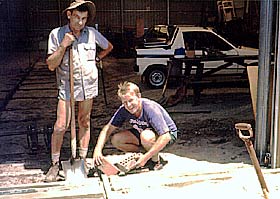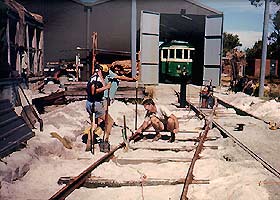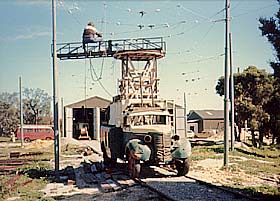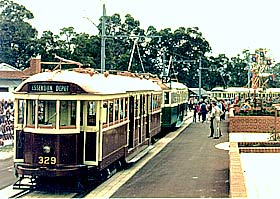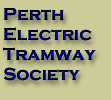
Site Index

About PETS:
 What We Do What We Do
 Our Mission Our Mission
 Society History Society History
 The Future The Future

|
|
About the Perth Electric Tramway Society [PETS]
|
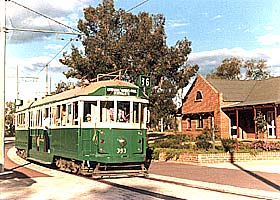 |
|
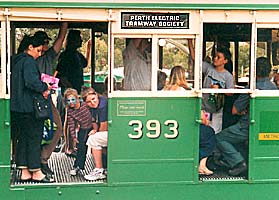 |
What We Do
The Society restores and operates heritage electric tramcars at Whiteman Park, where visitors can experience for themselves the delights of this form of transport from an earlier era. The trams run from the Mussel Pool picnic area to Whiteman Village, and connect to the Park's narrow gauge railway at Whiteman Village Junction.
Our workshops and Carbarn contain the fleet of operating tramcars, and also the maintenance areas. Trams currently in service include W-class cars from Melbourne, Australia, and a restored tram from Fremantle. Fares for the tram rides are our main source of funds for the restoration of further trams from Western Australia, and for fulfilling our wider aims as detailed below.
Our members are enthusiasts for this form of transport. The Society members you see, and those you do not see - the conductor and motorman on the tram, the track maintenance team, the overhead line team, the tramcar maintenance workers, the tram restoration team, the administrators - are all volunteers.
Mission Statement
The mission of the Perth Electric Tramway Society is to operate and develop Western Australia's Heritage Tramway and associated collections of equipment, artefacts, memorabilia and archival materials as a recreational and officially-recognised educational resource for present and future generations.
Objectives
Heritage Tramway
To provide a unique attraction for the public – operating historic electric trams – as a major component of Whiteman Park's heritage transport theme.
Trams
To assemble a collection of fully restored, operating examples of the various types of electric trams and trolleybuses which saw service in Western Australia; and, where appropriate, to include other Australian and overseas examples.
Collections
To conserve and develop the Society's collection of tramway equipment, artefacts, memorabilia and archival materials and make these accessible to the public, where appropriate, through comprehensive interpretive displays.
Knowledge
To achieve widespread official recognition as the main authority on electric tramways in Western Australia.
Status
To attain national and international recognition for our achievements in tramway heritage preservation, operation and display. |

PETS' History and Achievements
End of tramway operations in Western Australia - 1958
Electric tramway operation in Perth ceased in July 1958. The other large Western Australian tramway systems, in Fremantle and Kalgoorlie, had closed in 1952.
On 10 November 1960, a meeting was held to discuss the ongoing preservation of Perth tram 66, which had been kept intact and was then on display in the open at the Perth Zoo. This meeting was attended by Lindsay Richardson, Ric Francis, Don Tyler and the late Jack Stanbridge. That occasion can be regarded as the real birth of the tramway preservation movement in Western Australia.
Formation of the first transport preservation association - 1969
Following the closure of the Perth trolleybus system in August 1969, the first electric transport association was formed - the "Western Australian Transport Museum". Its objective was to restore and operate trams at Castledare Boys Home. A short-lived period of activity at the Wanneroo Lion Park also took place in the late 1970s, and a plan to operate the trams in Fremantle was also investigated.
Through the 1970s the first of the collection of WA tram bodies as well as the first two of our Victorian trams were acquired. |

Formation of Perth Electric Tramway Society - 1981
In 1981, the Western Australian Transport Museum divided into two societies. Members with an interest in electric traction formed the Perth Electric Tramway Society, while those interested in motor buses formed the Bus Museum of Western Australia.
Early developments at Whiteman Park - 1982-1985
In 1982 the opportunity came for the group to find a permanent home in Whiteman Park, a recreation and heritage park then in its early stages of development. The Society's plan was to operate, within the Park, a fleet of mainly W-class trams from Melbourne, with money raised from fares being used to fund the restoration of Western Australian cars.
This was the beginning of a period of intense development, capital investment in Whiteman Park, and input of members' skills and labour. Site works and construction began immediately, and the Oketon Geddes Carbarn was completed in March 1983. All trams and equipment were transferred from Castledare a few months later.
The desire to operate the Melbourne tramcars led to the decision at this time to use standard gauge [4' 8.5"] rather than the narrow gauge [3' 6"] actually used by Western Australian tramways. This decision was made with the knowledge that standard gauge equipment for restoration purposes was much more readily available. Fortunately the width of the W. A. tramcar bodies made this quite feasible.
The biggest challenge facing the group was to establish electrical operation. The difficulty of this should not be underestimated. Tramcar operation in Western Australia had ceased nearly 25 years previously, and electric trolleybuses ceased to run 11 years after that. All tramcar electrical fittings, motors, etc, all power generating equipment, and all overhead gear, had been scrapped. Tramway museums in other Australian states, in contrast, had received donations of tramcars in operational condition, other associated equipment, and direct input from transport organisations.
In Western Australia there was no continuity of operation – the group had to acquire or manufacture the equipment needed to convert the incoming 440 V alternating current into 600 V direct current, and transfer this current to the tramcars.
Another major achievement was the laying of track and point work in and around the Carbarn. This technically difficult and physically demanding task came at a time when members' skills in this area were developing, and when limited equipment was available to assist the process. |

| The first 1 kilometre of track was constructed from the Carbarn to old Mussel Pool stop.
Overhead wiring was installed during 1985: |
| At this time also the W. P. Pennenburg Workshop was built. Further trams were acquired from Victoria, to form the operating fleet, and heritage Western Australian tram bodies continued to arrive, for ultimate restoration. |

Beginning of tram services at Whiteman Park - 1985
Public services began with the official Society opening ceremony on 30 November 1985. Return fares at that time were Adult: $1.50 and Child: 50c. Services were provided on Sundays between the Carbarn and the original Mussel Pool stop.
Official opening of Whiteman Park - 1986
During 1986, track was finished and overhead installed from (old) Mussel Pool to Village and Central Station, then from Triangle to Entrance.
Services commenced over the whole system at the official opening of Whiteman Park on 21 September 1986: |
At this stage the operating fleet consisted of W2 cars 329, 368, 393 and W4 674. Several years later SW2 426 was also acquired from Melbourne and subsequently joined the operating fleet. Ballarat single-truck tram 31 was used on special occasions.
Tramcar restoration - 1983-1992
The other fundamental task for the group – indeed, its main raison d'être – was the restoration to operating condition of local tramcars, of which Fremantle Municipal Tramways #29 was to be the first. This undertaking was also monumental. No electrical or other operating equipment for tramcars was available locally, and this had to be acquired or made. For safety of operation the body had to be completely stripped to ensure its structural integrity. Seats had to be manufactured and assembled, and all surfaces finished to the high standard associated with the Fremantle Municipal Tramways.
While the Society's early emphasis had to be on building infrastructure and developing traffic operations, restoration work continued over the years, and 16 August 1992 saw the official return of Fremantle #29 to regular service, some 40 years after the closure of the Fremantle tramway system.
1992 also saw the Society acting as the Host museum for the biennial Conference of the Council of Tramway Museums of Australasia [COTMA]. |

Consolidation and development - 1992-present
In the years since 1992 we have continued to give visitors the experience of travelling on these heritage vehicles; at the same time, many other Society activities have developed:
- The ongoing need for infrastructure upgrading has seen the inroduction of programmes to
- replace wooden traction poles with steel or concrete
- replace wooden sleepers, at the end of their useful life, with steel sleepers
- erection of further buildings for tramcar storage and maintenance
- acquire ancillary equipment for use in maintenance and restoration
- Safety of members and the public has always been a Society imperative. In recent years the need to gain Rail Safety Accreditation has required a concerted effort to document the procedures which we had developed. The Society was successful in gaining accreditation from the W. A. Department of Transport in May 2000.
- Tramcar restoration and preservation has continued. Perth tram #66 [E class of 1917] is currently the main focus of restoration efforts, which are lengthy due to the need to ensure the structural integrity of the car. Work to preserve or prevent deterioration in other tram bodies such as Perth G 35, originally Kalgoorlie 16, has also been undertaken.
- Since 1992 several mobile displays have been developed, with information and photographs about tram operations in Western Australia and PETS operations at Whiteman Park.
- Further tramcar and trolley-bus bodies have been added to the Society's collection for preservation and eventual restoration.
- The Society has assisted in the publication of books about Western Australian tramways, and has expanded its range of souvenirs and other items on sale.
- Archival collections have expanded with the donation or copying of photographs and other records.
|

The Future
The Society aims to continually improve its presentation of the story of Western Australian trams to the public of WA by:
- developing a comprehensive tramway historical display and educational facility, in association with the proposed Transport Heritage Centre
- continued provision of the "living museum" experience - rides on heritage trams
- completion of the restoration of Perth tram #66
- restoration and operation other WA and Australian trams
- restoring Western Australian trolley-buses, and operating them within Whiteman Park
- completion of the engineering shed and associated facilities for maintenance and restoration
- building a strong membership to assist with fulfilling our objectives
|

|
|

